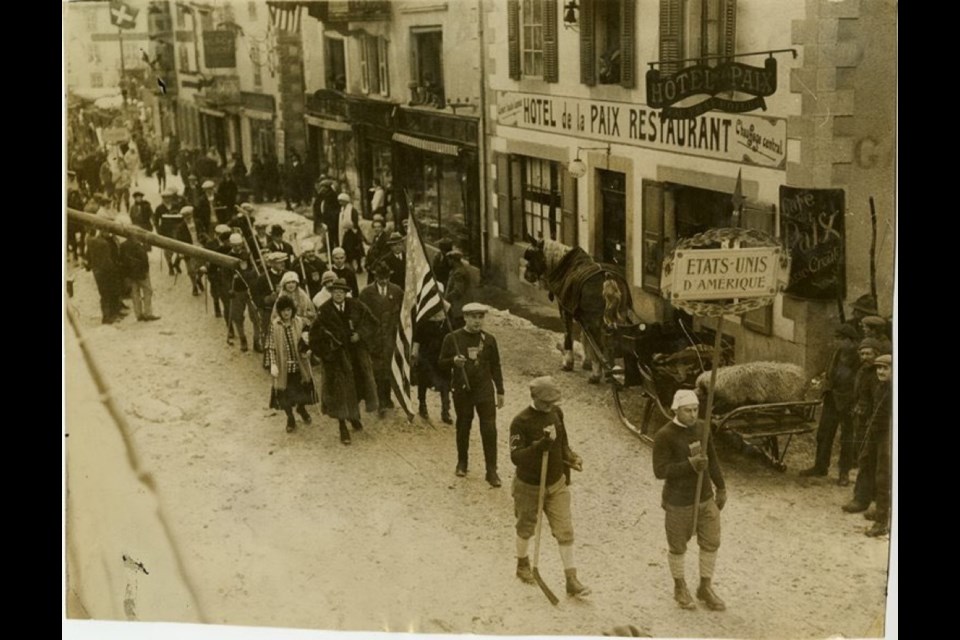Editor's note: This is Part 2 of a story about Herb Drury, a local hockey star who went to represent the United States at two Olympic Games. To read Part 1, click here.
Hockey had made such a strong impression among Olympic officials that it was decided the next Olympiad would see separate Summer and Winter Games.
Herb Drury, who was born in the former Medonte Township in 1894, continued to play for Pittsburgh after the Olympics.
But when the club from St. Paul, Minn., which had been chosen to represent the U.S. for the 1924 Games in Chamonix, failed to impress in exhibitions against top American clubs leading up to the tournament, Drury was once again called upon to represent his adopted homeland.
Those first Winter Games were dwarfed by modern ones, with 350 athletes competing in 16 events.
Chamonix officials were worried that the village of 3,500 would have trouble accommodating the predicted 25,000 competitors, coaches, officials, press and spectators.
The actual total was far less, but there was unanimous consent that the Games were a success. The world took notice of the performances coming out of the French town.
The sweetheart of the Games was an 11-year-old Norwegian named Sonja Henie, who finished last in the women’s figure-skating competition. Henie would win gold at the next three Olympics, along with ten world championships, and at the peak of her fame was one of Hollywood’s highest-paid actors.
After a 10-day journey by ship and train to get to the resort village in the southwest of France, both the American and Canadian teams were surprised by the outdoor rink where the hockey games would take place.
The ice surface was far bigger than the standard North American one, measuring about 200-by-200 feet. In addition, the boards around the ice were knee-high, meaning that teams wouldn’t be able to play the puck off of them.
Complicating matters was that when the teams arrived in late January, a thaw had made the rink all but unplayable. The Americans and Canadians had to resort to road work to keep up with their conditioning, and could get only one practice in before the tournament began.
On Jan. 25, the Opening Ceremonies took place with Drury carrying the United States placard as the teams paraded through the main street of Chamonix on their way to the stadium.
Once play began, two teams dominated their respective pools.
In three preliminary round games, Canada outscored their opponents 88-0, while the Americans trounced the opposition by a cumulative score of 52-0.
In the medal round, the Canadians trounced England, 19-2, to advance to the gold-medal game, while the U.S. whipped Sweden 20-0.
Drury was the tournament’s leading scorer through the first and second rounds.
That set the stage for the final, but in reality it was no match at all.
Canada was represented by the Toronto Granites, Allan Cup winners of the previous two seasons, and Ontario Hockey Association senior champs in three of the past four. Ten Granites’ players went on to play in the National Hockey League, and two were later inducted into the Hockey Hall of Fame.
The width of the rink had been reduced, but because of the lack of boards, the majority of the play was in the middle of the rink.
Canada, superior in terms of skill and depth, carried the majority of the play, in an era where forward passing was not permitted in the offensive zone.
Drury, the only real scoring threat on the American side, was tightly checked throughout the game, and while he scored for the U.S. It was to be the team’s only goal, as Canada took gold with a convincing 6-1 victory.
American reporters not completely familiar with the game groused about the refereeing, but Drury said the Canadians were full measure for the victory.
“We were beaten by a better team,” Drury told the Montreal Star after the gold-medal contest. “When we took to the ice, we faced a superior outfit, one that had a roster who were the cream of the players in Canada.”
The 1924 Games were to be Drury’s last.
The following year, his Pittsburgh team joined the NHL, and while he was no longer a star due to his diminishing speed and the league’s smaller ice surfaces, he was an effective player for the rest of the decade.
In his retirement, Drury operated a popular restaurant in a city suburb for several decades before passing away in 1965.
Herb’s brother, Morley, was to go onto even greater fame. A multi-sport athlete in high school, Morley became known as one of the greatest University of Southern California football players of all time, and was nicknamed “The Noblest Trojan of Them All.”
He was elected to the College Football Hall of Fame.
Both Drurys were inducted into the Midland Sports Hall of Fame in 2010.
D.M. Fox was, like Herb and Morley Drury, raised in Midland. He has written two books of historical baseball fiction partly set in North Simcoe. “On Account of Darkness: the Summer Ontario Baseball Broke the Colour Barrier,” and “Severn Sound: a Big Leaguer Comes to Port McNicoll,” are both available on Amazon/Kindle, and most ebook platforms.



